When you are running a large-scale business, you need a platform that can handle high volume, complex needs, and ambitious growth goals. Between the two industry leaders – Shopify Plus vs Magento, you may find it hard to decide which is the perfect fit for your business. Luckily, you have come to the right place!
In today’s blog post, we will break down all the details you need to know about Shopify Plus vs Magento (or now Adobe Commerce), following these key points:
- Pricing
- Apps & integrations
- eCommerce features
- Customization & flexibility
- SEO functionality
- Security
- Community & support
Not gonna let you wait any longer; here we go!
Shopify Plus vs Magento – An Overview
Before diving into the differences between Shopify Plus vs Adobe Commerce (formerly Magento), let's first learn the fundamentals of each platform.
Shopify Plus operates as a fully hosted Software-as-a-Service (SaaS) platform. It handles all the technical responsibilities, such as server management, security updates, and software maintenance. Thanks to this, business owners can concentrate entirely on running and growing their online stores without having to deal with complicated backend tasks.

Many fast-growing brands and enterprises, such as Kylie Cosmetics, Allbirds, and Decathlon, choose Shopify Plus because it combines simplicity, stability, and strong enterprise-level capabilities all in one package. Below is a quick overview of Shopify pros and cons for your consideration.
Pros | Cons |
- Can handle massive traffic and high order volumes without compromising site performance. - Offer extensive customization options to tailor your storefront, checkout process, and backend workflows. - Supported by a dedicated Merchant Success Manager for personalized guidance. - Get access to Shopify Plus-exclusive features like Shopify Flow for automation and Launchpad for flash sales. - Integrates seamlessly with a wide range of third-party apps and services to streamline your operations. | - Charge higher monthly fees compared to standard Shopify plans, making it a significant investment for smaller businesses. - Require a high level of technical expertise to handle advanced features and customization options. - Demand dedicated time and resources for training and onboarding. |
On the other hand, Magento, which is now officially known as Adobe Commerce, gives businesses a much greater level of control over their online store’s design, functionality, and infrastructure. As an open-source platform, Magento allows businesses to access, customize, and modify the platform’s code to fit even the most complex and unique business needs.
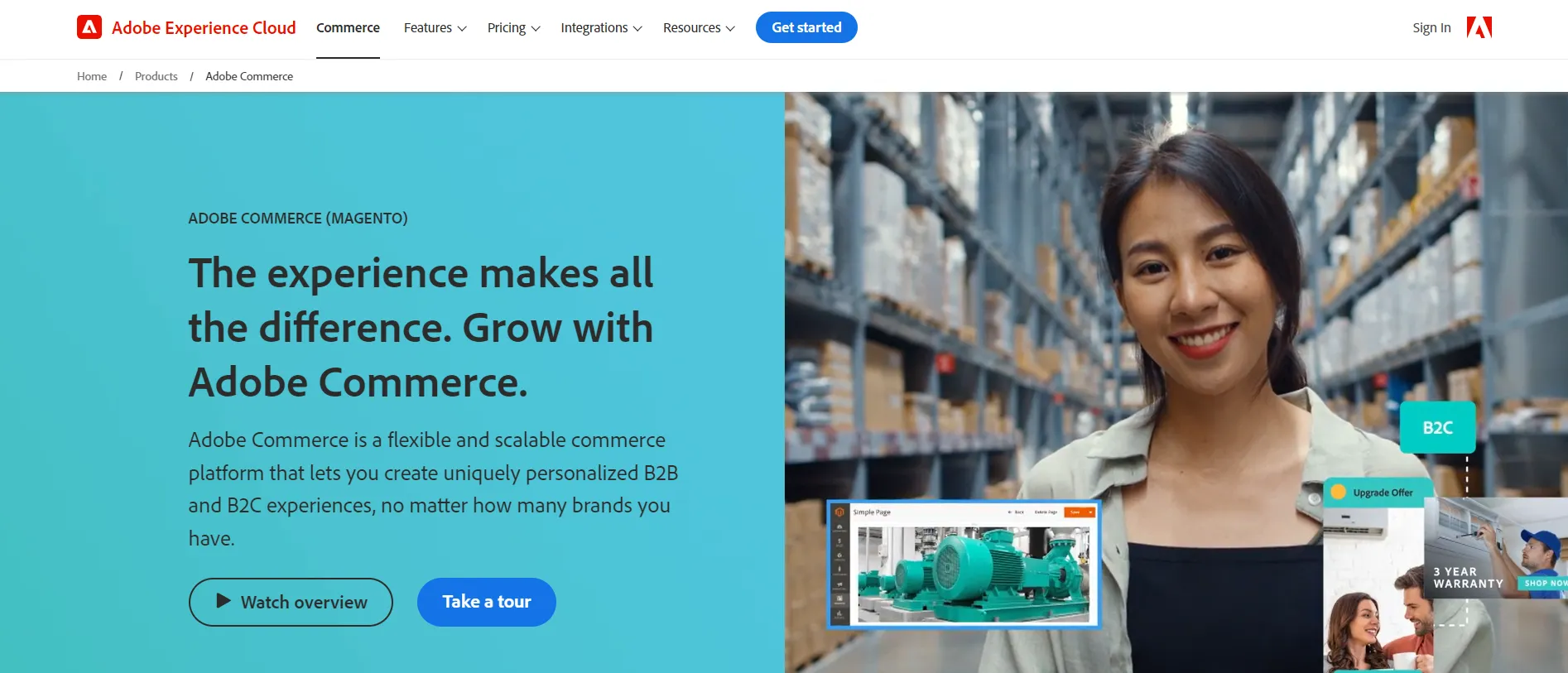
This level of flexibility makes it an attractive choice for companies that require very specific customizations or operate in industries with non-standard workflows. Businesses that select Magento typically have advanced customization requirements, complex product catalogs, or unique operational processes that may not be as easily supported by more out-of-the-box solutions like Shopify Plus.
Here are the Magento pros and cons for your reference:
Pros | Cons |
|
|
Shopify Plus vs Magento: Which Platform is for You?
Both Shopify Plus and Adobe Commerce (or previously Magento) are strong contenders for high-growth businesses. However, when we delve deeper into this eCommerce platform comparison, it becomes clear that each caters to a distinct audience. Ultimately, the best choice depends on your specific needs and requirements.
To help you quickly grasp the key differences, we’ve created a side-by-side comparison table that evaluates Shopify Plus vs Magento across the most important criteria
Criteria | Shopify Plus | Magento (Adobe Commerce) | The Winner |
Pricing | From $2,500 per month for 1-year contract | Variable costs with additional fee for hosting and devs | Shopify Plus |
Apps & Integration | Large app ecosystem with easy plug-and-play setup | Robust extensions, but more technical to integrate | Shopify Plus |
eCommerce Features | Built-in features for omnichannel, B2B, subscriptions | Advanced capabilities, customizable workflows | A Tie |
Customization & Flexibility | Limited backend control | Full code access, highly flexible for complex needs | Magento |
SEO Features | SEO-friendly but some structural limitations | Advanced SEO features and fine control | Magento |
Security | PCI-DSS compliant, built-in SSL, monitored infrastructure | Manual security setup and ongoing patch management required | Shopify Plus |
Community & Support | 24/7 support, dedicated success managers, rich docs | Strong developer community | Shopify Plus |
If you are still sitting on the fence about which platform to go for, the criteria below may help you decide.
Choose Shopify Plus if:
- You want a platform that's easy to set up and use without requiring extensive technical knowledge.
- Your business doesn't require a high degree of customization.
- You're comfortable using apps and integrations to extend the functionality of your store.
Choose Magento, or Adobe Commerce, if you are:
- You prioritize customization and scalability. You need a platform that can grow and adapt to your business.
- You have an extensive product catalog or complex inventory management needs.
- You have the technical expertise to manage and maintain an Adobe Commerce store.
Pricing (Shopify Plus wins)
Shopify Plus starts at a flat rate of $2,500 per month (1-year term). This fee has already covered many core services, such as hosting, scaling, support, and upgrades, which would otherwise incur additional costs.

The exact pricing of the Shopify Plus plan is also based on your GMV. You can refer to the below breakdown of the Shopify Plus licensing fees according to GMV ranges:
Gross Merchandise Value | Shopify Plus License Cost |
$1M | $4,000 |
$2M | $8,000 |
$5M | $20,000 |
$10M | $40,000 |
$20M | $80,000 |
$50M | $200,000 |
On average, most businesses pay between $60,000 and $200,000 to run their Shopify Plus stores, depending on the project scope and website complexity.
On the other hand, Magento, or Adobe Commerce, offers three different editions: SaaS, PaaS, and Optimizer. The annual license fee for these versions varies depending on the average order value, the gross market value (GMV), selected package, and other optional costs. To visualize how much Adobe Commerce costs, please take a look at the following table:
Types of costs | Estimated price |
Annual cost | |
Mandatory license fees | $22,000 – $125,000+ per year (based on GMV/AOV) |
Hosting infrastructure | Included in SaaS & PaaS (external for on-prem) |
Development & maintenance | $10 – $200/hour, or up to $120,000/year (agency/in-house) |
SEO & marketing tools | $25 – $1,200+ per year (plugins, integrations) |
Optional/One-time costs | |
Domain name | $10 – $20/year |
Themes | $0 – $499 (depending on design needs) |
Extensions (modules) | $0 – $100,000 (based on functionality required) |
From our experience, an Adobe Commerce build typically ranges from $122,000 to $450,000. The exact cost can vary significantly depending on the agencies or partners involved and the level of complexity regarding features, integrations, and customizations.
- PaaS (Adobe Commerce on Cloud): Typically $40,000 – $200,000/year, including cloud hosting.
- SaaS (ACCS, launching June 2025): Expected to offer tiered, lower infrastructure costs, but official rates not yet disclosed.
- Optimizer: Modular pricing based on selected storefront and merchandising capabilities.
The verdict
In terms of pricing, Shopify Plus takes the lead over Adobe Commerce, regardless of which edition you choose. Adobe Commerce is usually more costly to maintain than Shopify Plus because it demands greater investment in platform and infrastructure upkeep.
Apps & Integrations (Shopify Plus wins)
When it comes to apps & integrations between Shopify Plus vs Magento, Shopify has already shone with its massive app store, which is available for merchants from all pricing plans. It offers 8000+ high-quality, advanced apps that can significantly enhance a brand's tech stack. Features like wishlists, loyalty programs, tracking, and personalization are readily available from numerous top-tier vendors, making implementation much quicker than Adobe Commerce. 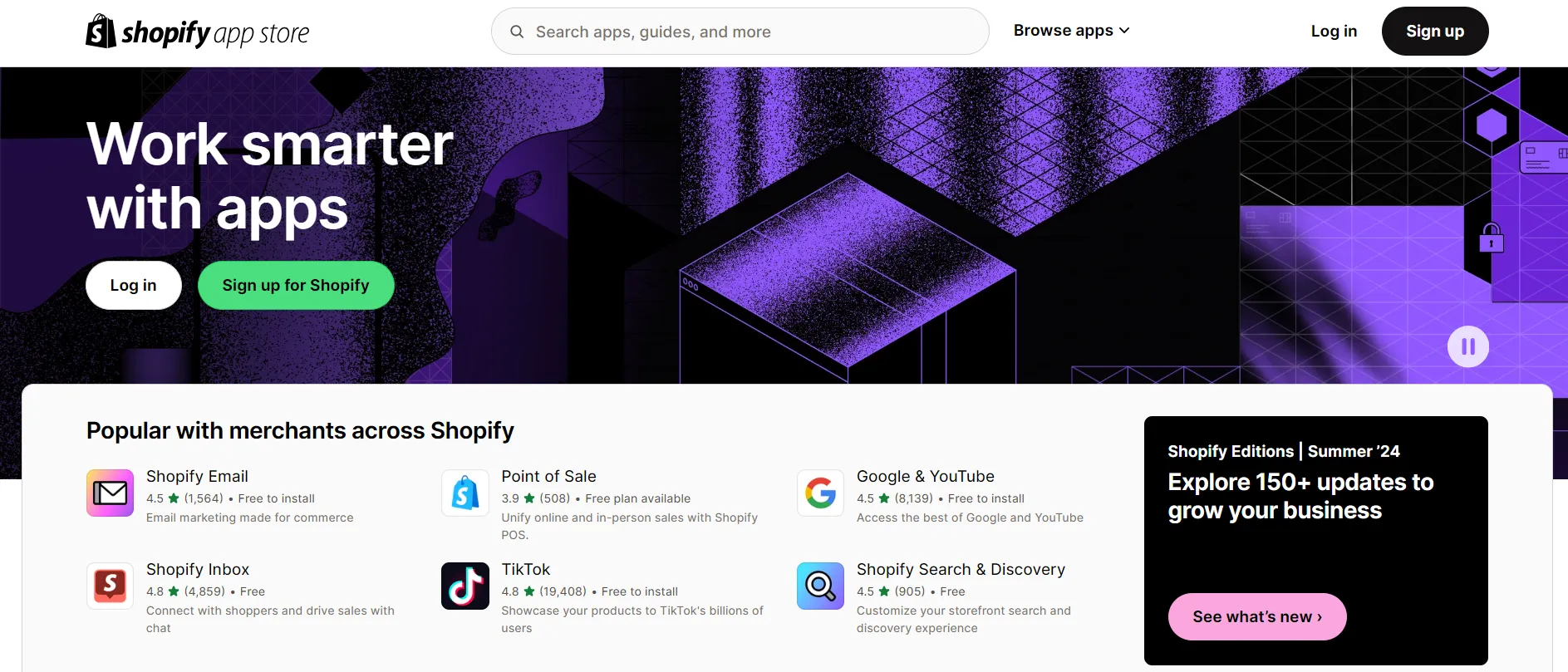
- ERP integration allows you to connect your Shopify store seamlessly with your Enterprise Resource Planning system, synchronizing inventory, orders, customer data, and financial information.
- Shopify Flow enables the automation of complex business processes, such as tiered pricing logic or bulk order fulfillment.
- Shopify Function APIs create custom apps to meet the unique requirements of your enterprises.
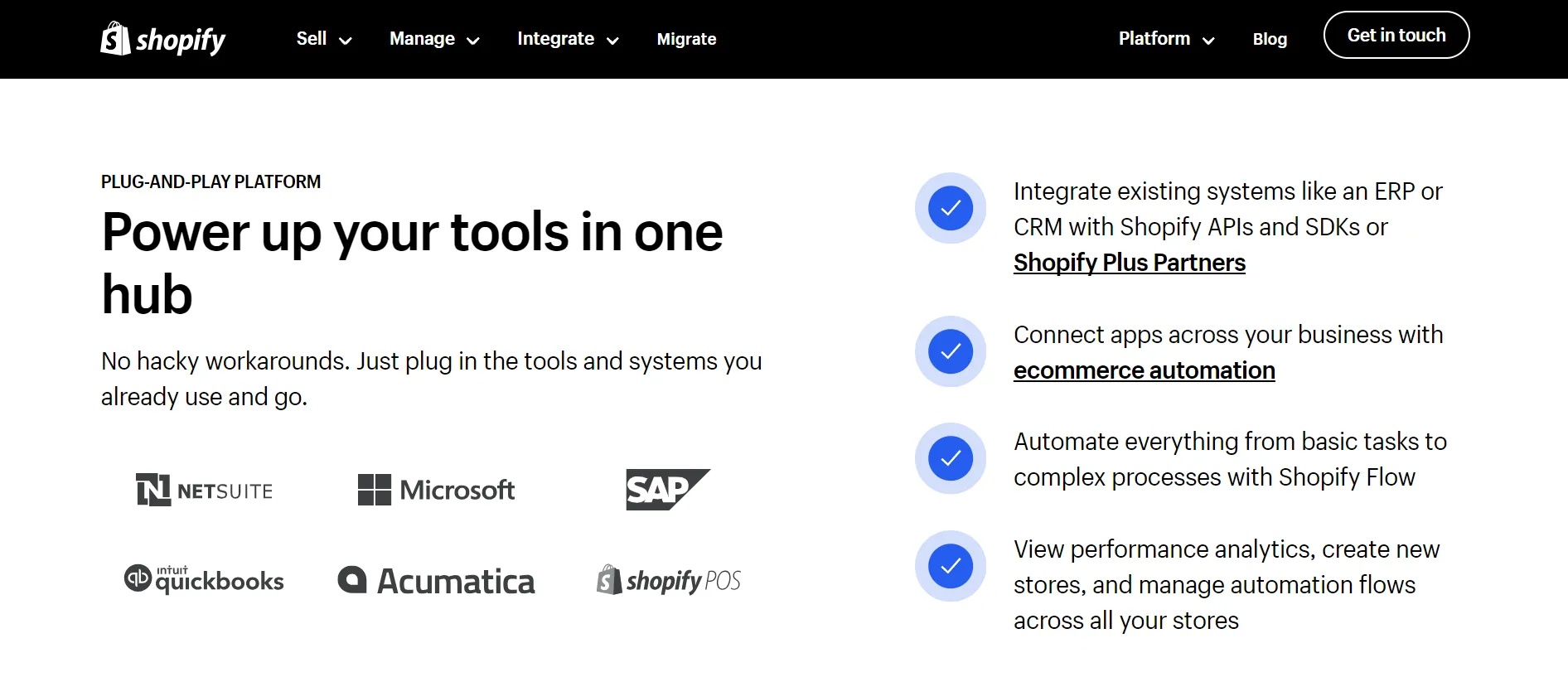
Next, let's talk about Magento, or Adobe Commerce. You can easily extend your store functionality by installing apps from the Adobe Commerce Marketplace. There are a variety of selections for you to choose from, including payment gateways, shipping, marketing, fulfillment, etc.
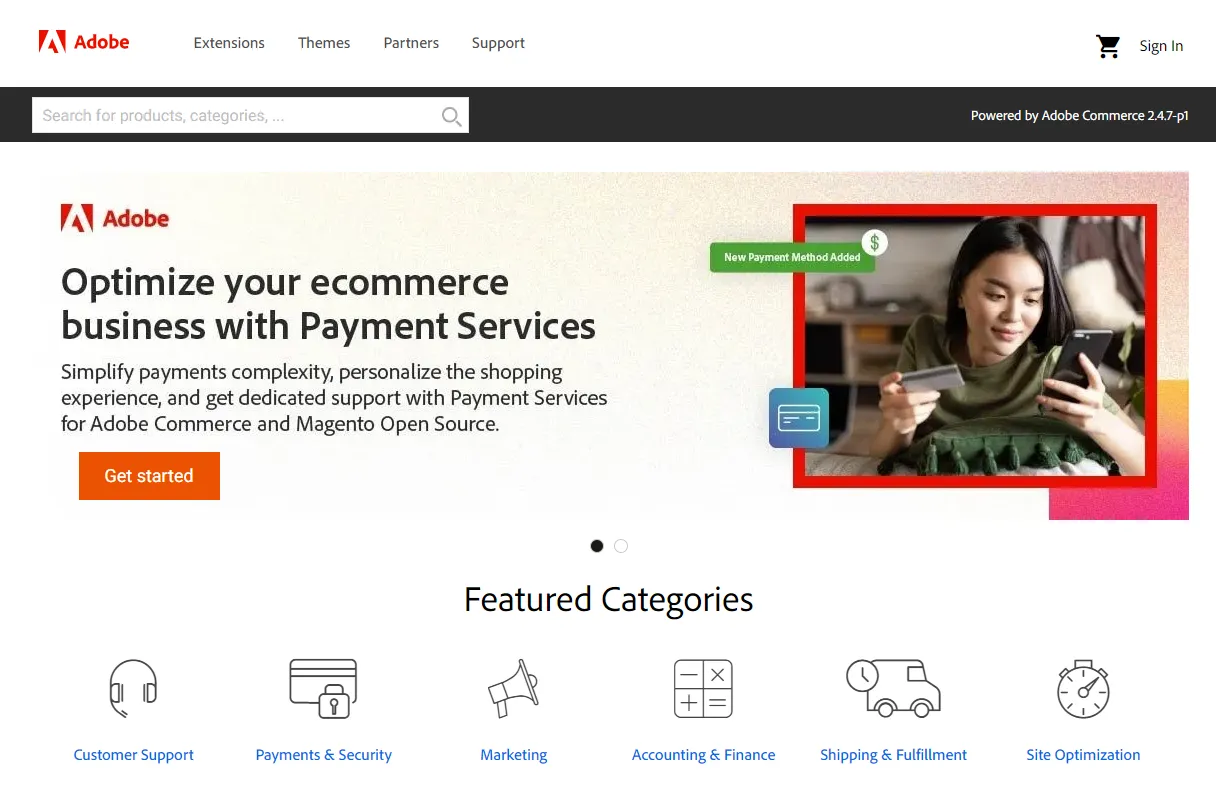
Integrating with Adobe Experience Cloud products can also enhance the capabilities of your online stores. This is a powerful ecosystem of marketing, analytics, and personalization tools.
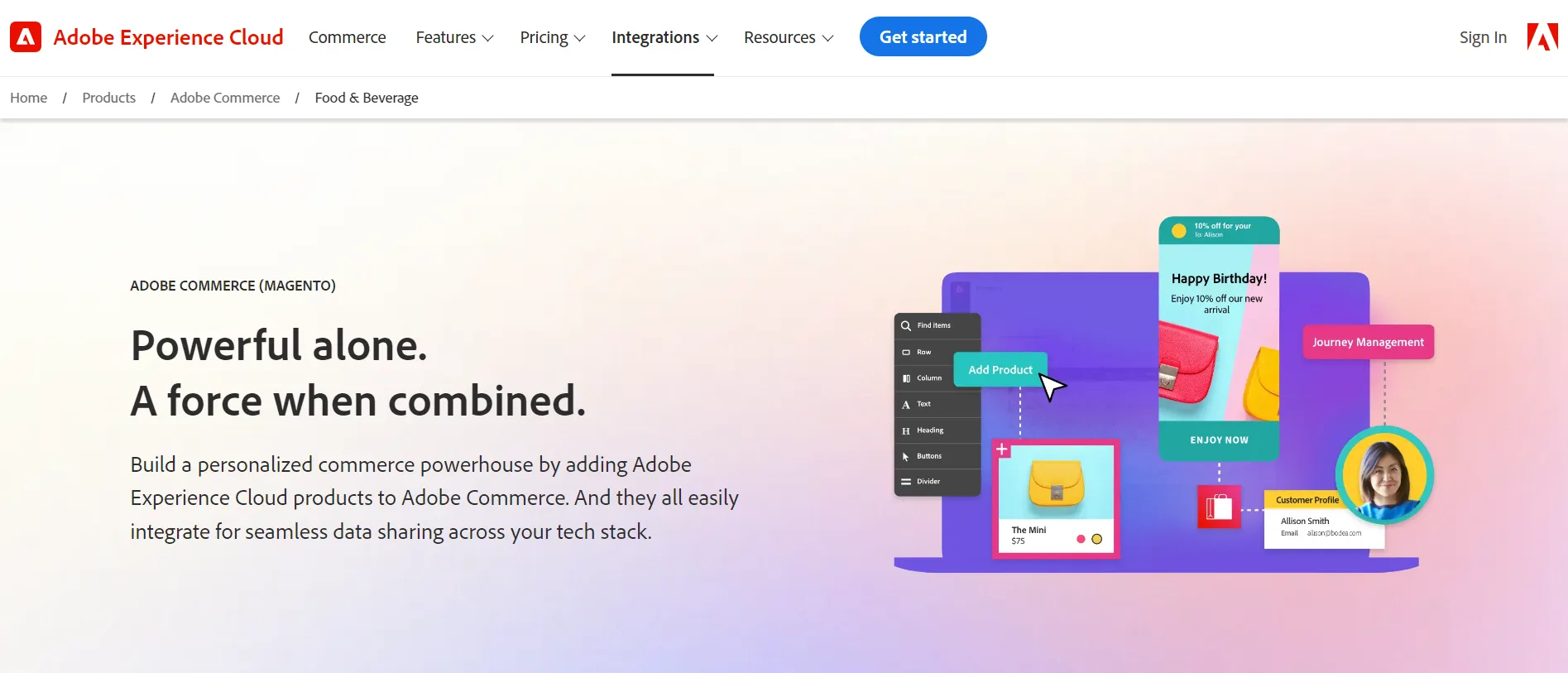
The Verdict
When putting Shopify Plus vs Magento together, Shopify Plus won this round with its wide range of pre-built solutions. Even if you want customized apps for your own business, Shopify Plus can easily fulfill your requirements, too.
eCommerce Features (A tie)
You can’t skip out on the eCommerce features to get your businesses running smoothly. So, in the competitive race between Adobe Commerce vs Shopify Plus, which platform wins in this aspect?
Before going into the details, let’s take a quick overview of all the eCommerce features offered by both Adobe Commerce vs Shopify Plus:
Features | Verdict |
Shopify Plus is the go-to option for easy use and a streamlined approach. For businesses that require extensive product customization, Adobe Commerce offers more power but potentially more complexity to manage. | |
Shopify Plus is generally easier to manage, while Adobe Commerce caters to very large and complex operations. | |
Adobe Commerce offers deep customization but demands technical expertise and higher costs for multiple stores. Shopify Plus Markets prioritizes user-friendliness and scales well but lacks robust features. | |
Shopify Plus offers a more modern approach with its growing headless ecosystem and third-party customization options, making it a strong contender in the headless commerce race. | |
Shopify Plus stands out with a user-friendly interface and out-of-the-box core metrics, making it ideal for those prioritizing simplicity. | |
Shopify Plus takes the lead in the payment section thanks to its competitive fees and the convenience of Shopify Payments. | |
While Shopify Plus is making strides in improving its B2B/wholesale offerings, Adobe Commerce currently provides a more mature and tailored solution for B2B/wholesale needs. |
Inventory & products
Shopify Plus offers limited product types, including simple, downloadable, and virtual products. However, you can still use product variants for configurable products and sell downloadable items with additional apps.
According to the latest update, Shopify Plus has decided to increase its variants limit from 100 to 2000 per product. If you want more product variants than the maximum number, you can request Shopify Plus support for help.
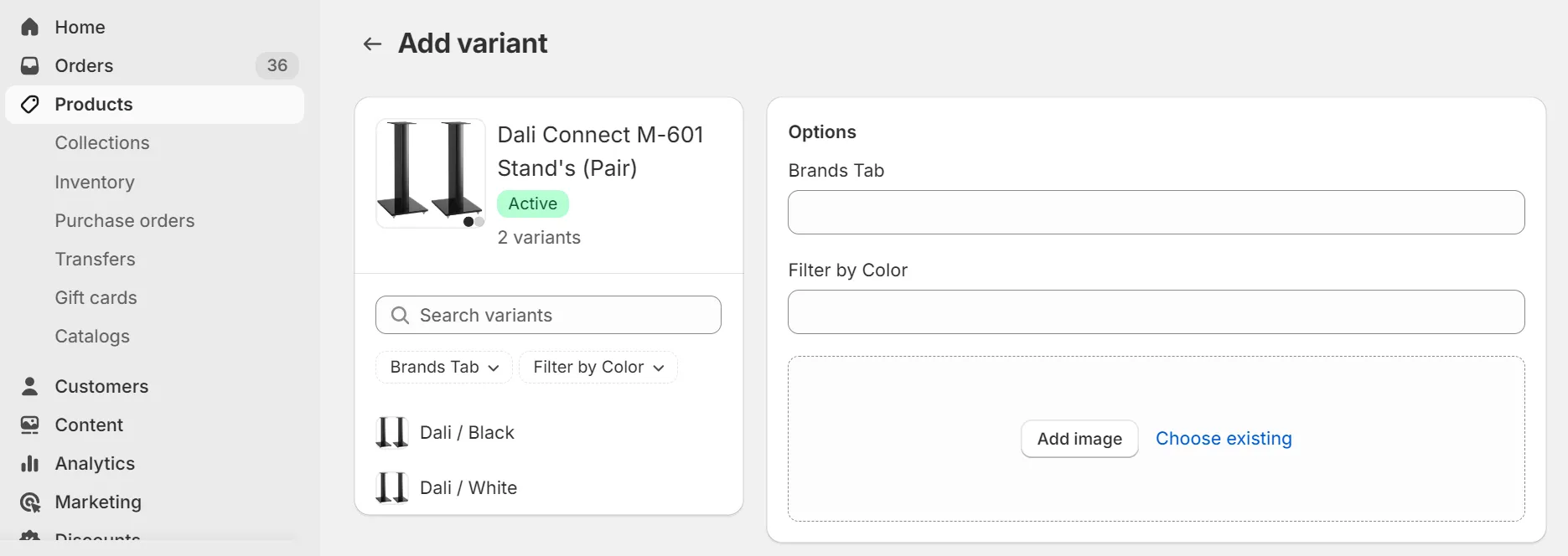
We must say that Shopify Plus’s native features, like easy CSV import/export, make adding and updating products a breeze. Hence, extending product functionality becomes much easier despite the fact that it only has one single product type.
On the flip side, Adobe Commerce offers a more robust solution for businesses with complex product structures and data requirements. It boasts up to 6 native product types, including bundled products and grouped products. This allows for more extensive control over how products are presented and sold.
Additionally, Adobe Commerce offers greater customization capabilities, catering to businesses that need to store and manage a wider variety of product data points. However, this flexibility can come at a cost, as setting up and managing a complex product catalog in Adobe Commerce might require more technical expertise.
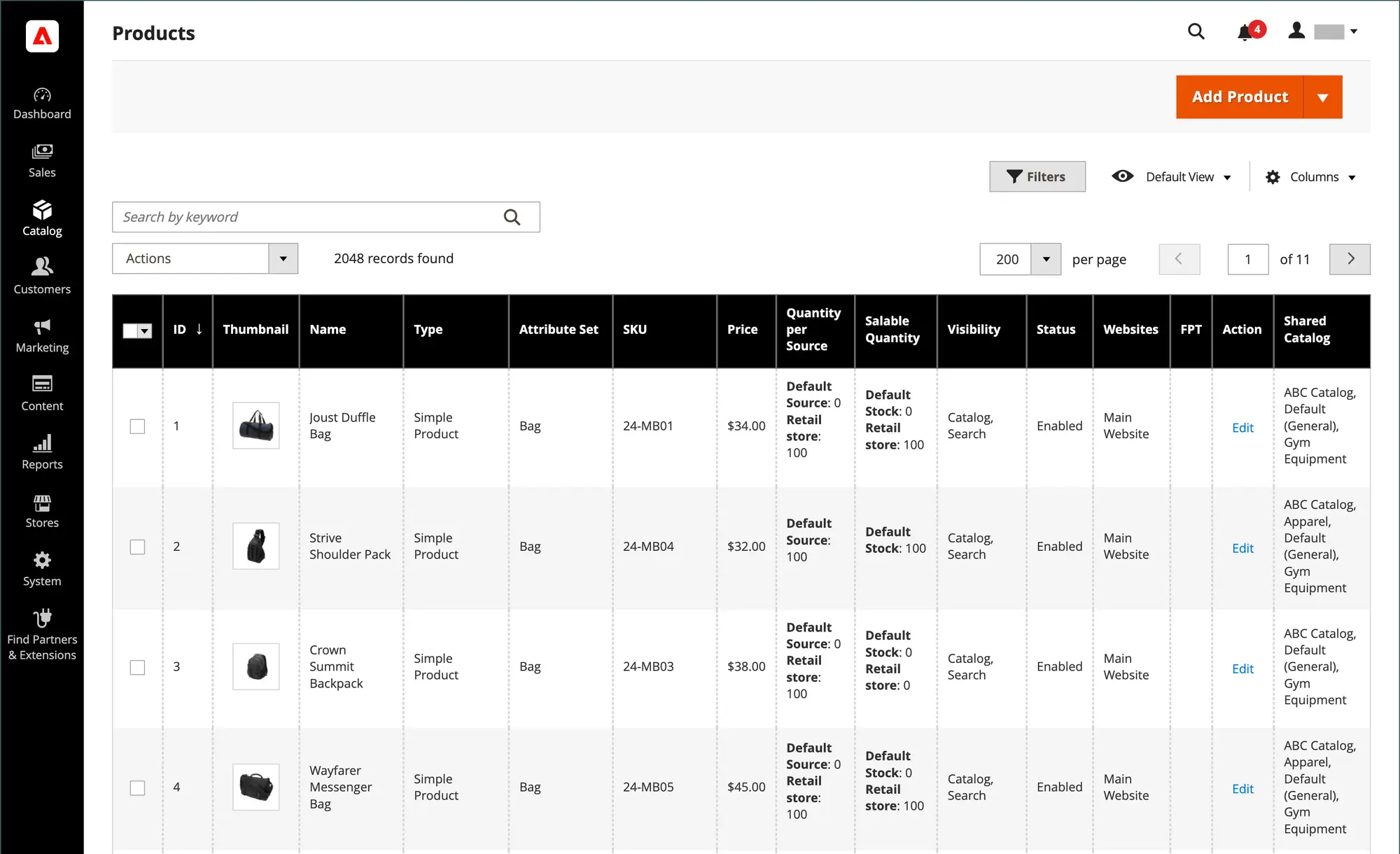
Multistore management
Using this eCommerce solution, businesses can own multiple Shopify stores on Shopify Plus. For any additional stores, there is an extra charge of $250 per month per store or a revenue share across all stores.
You can easily manage inventory, orders, customers, and content from a single admin panel for all your stores. This simplifies operations and ensures brand consistency across all your storefronts.
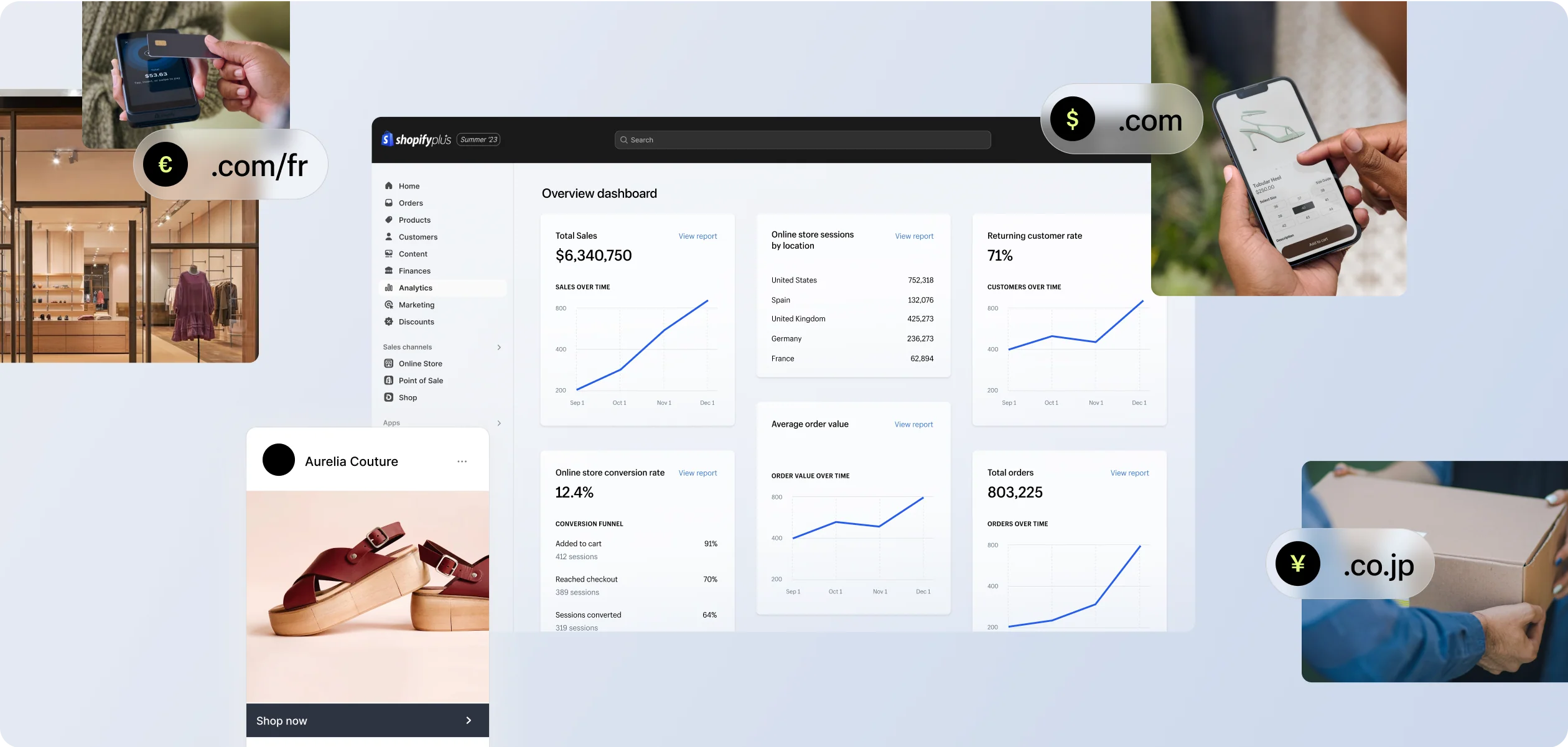
On the other hand, Magento excels at managing a vast network of stores, making it the winner in this round between Shopify Plus vs Magento. This is the platform's core strength, allowing businesses like Warner Music (multi-brand) and Nestle (multi-brand) to operate over 100 websites under a single account.
To manage many stores at once, Magento merchants can choose a centralized approach, similar to Shopify Plus, for streamlined operations and a consistent brand experience. But where it truly shines is the ability to manage each store individually. This empowers businesses like Nestle to cater to regional preferences or manage separate storefronts for each brand under their umbrella, like Purina and Häagen-Dazs.

Internationalization
For Shopify Plus businesses seeking to expand their reach beyond borders, Shopify Markets emerges as a game-changer. It empowers you to create and manage storefronts for up to 50 distinct markets, offering incredible flexibility to cater to a truly global audience.
Imagine seamlessly managing localized experiences for customers in France, Japan, and Brazil, all within a unified platform. Shopify Plus Markets allows you to translate content, configure local currencies, and tailor product offerings for each market.

But be aware of Shopify Plus's limitations. Accordingly, you can't assign products to specific inventory locations for different markets, nor can you use multiple business entities for complex financial management.
So what about Magento? It is no exaggeration to say that Magento (Adobe Commerce) is the top platform for internationalization. You can delve into the nitty-gritty of language translation, currency formatting, and regional tax regulations for each target market. This level of customization allows you to create unique experiences for each region, potentially boosting customer engagement.
However, this level of control comes with a price. Adobe Commerce requires a higher degree of technical expertise to configure and manage effectively. Moreover, the cost of additional licenses for each store can quickly add up for businesses managing an extensive network of localized storefronts.
Headless commerce
Both platforms, Adobe Commerce vs Shopify Plus, are viable for established brands with large technical teams.
Shopify Plus has emerged as a strong contender in the headless commerce space. Their recently introduced Hydrogen framework has fueled a surge in headless store development, attracting major brands like Skims and Gymshark.
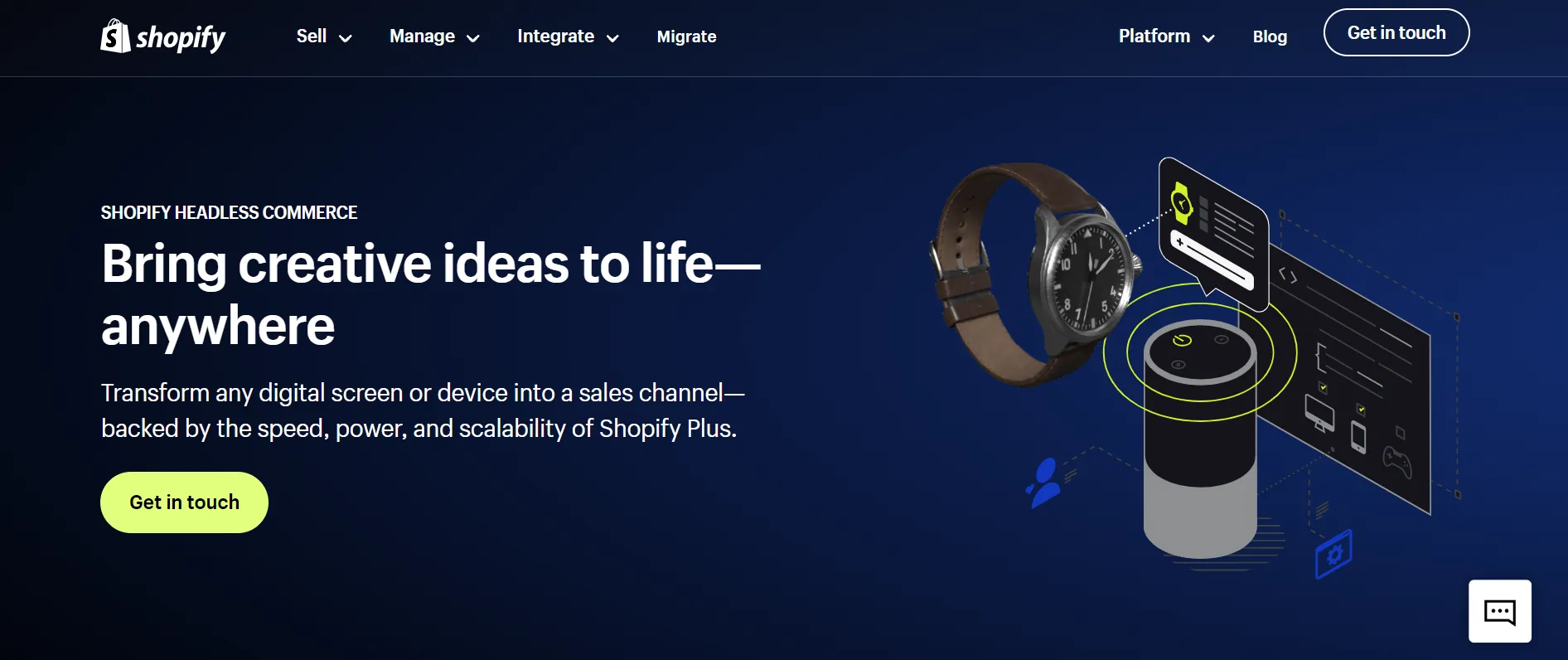
Beyond its own framework, Shopify Plus offers additional flexibility through third-party headless options like Nacelle and Pack, allowing for further customization.
At the same time, Adobe Commerce led the trend by introducing a headless solution called PWAStudio several years ago. However, widespread adoption and development haven't kept pace. While successful custom headless Magento stores exist, they often require a high degree of maintenance expertise, potentially becoming a burden for businesses.

Reports & analytics
While Magento, now known as Adobe Commerce, has not been its strongest suit in native reporting capabilities, the platform offers a powerful add-on that significantly enhances its reporting potential: Magento BI (now known as Adobe Commerce BI). This game-changer acts as a data warehouse, centralizing data from various sources within your business ecosystem.

If you sign up for the Adobe Commerce Cloud edition, you will have access to up to 100 pre-built reports covering various functions such as marketing, sales, and customer insights. Furthermore, you can even create personalized reports with custom metrics using the platform's built-in SQL report-building editor.
Shopify Plus takes a different approach, prioritizing user-friendliness and core metrics. Its clean interface makes navigating and understanding critical data points a breeze.
Out-of-the-box reports cover all the essential metrics you need to track your store performance, including sales performance, customer behavior, and inventory levels. Not to mention, you even have the ability to filter and edit data to create your own custom-built reports.

Payment gateways
When talking about Shopify Plus, its key aspect lies in the in-house gateway named Shopify Payments, which offers competitive credit card processing fees starting at 1.6%. This means you don’t have to pay transaction fees, which are around 0.15%/transaction extra for third-party payment providers.
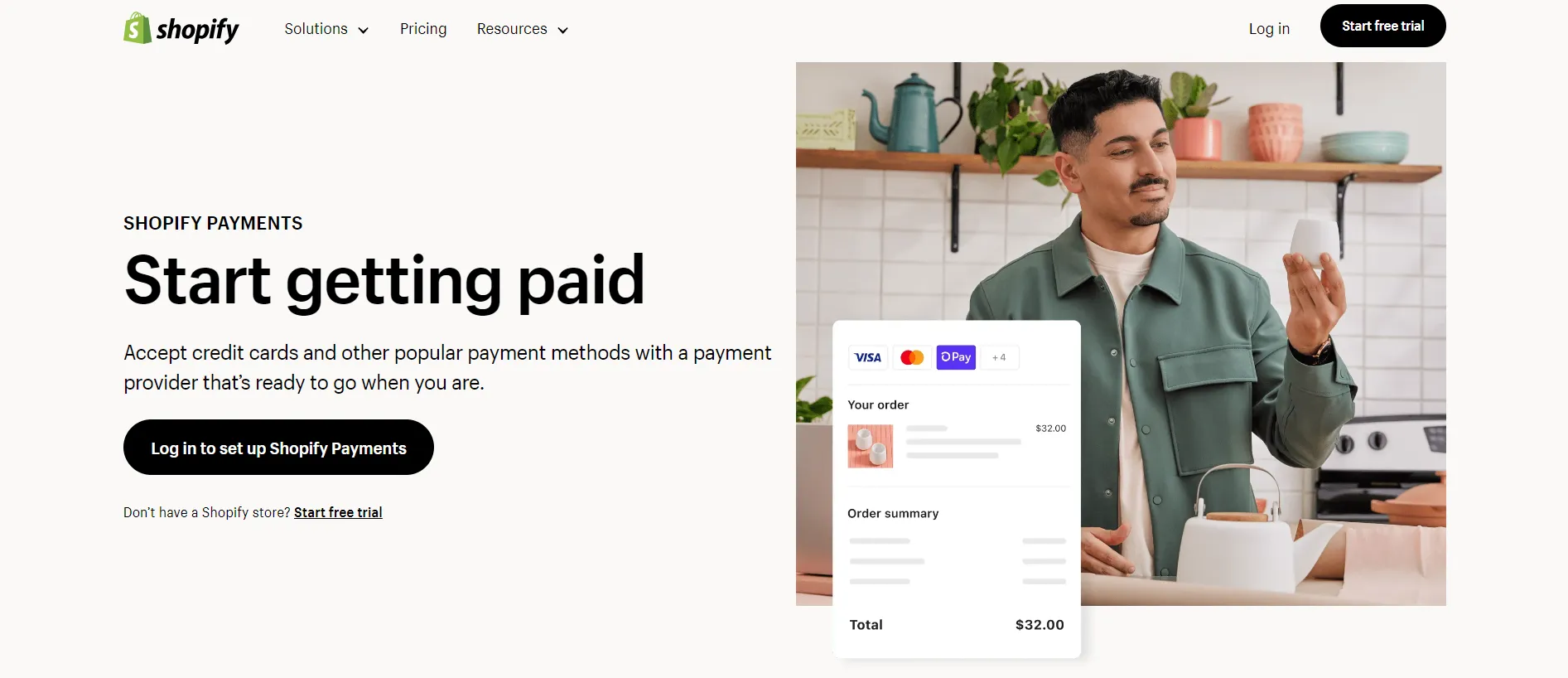
While it offers many benefits, it has some frustrations, including the requirement for a registered business and local bank account in each country of use. Shopify Payments isn't available in some regions (like European or ROW stores) and doesn't support several countries, such as France.
If Shopify Payments is not what you wish for, feel free to refer to 100+ other payment providers.

Meanwhile, Magento offers a wide array of payment options, including built-in integrations with Braintree, Adyen, Stripe, and most major payment gateways. Additionally, the platform includes a variety of pre-integrated payment solutions within its core, minimizing the effort required for integration.
Regardless of the Adobe edition chosen, you must cover transaction fees for online payments, typically ranging from 2% to 4% of the transaction value. These fees cover credit card processing and payment platform costs. Popular solutions like PayPal and Stripe, which are easy to integrate and have no setup fees, charge transaction fees starting at 2.9%.
Wholesale capabilities
For Shopify Plus, the platform also offers solutions like a dedicated wholesale channel and the option to set up separate stores for B2B operations. While these options provide some functionality, they lack features that are crucial for many B2B businesses. For example, advanced pricing rules might require workarounds, and functionalities like separate shipping rules for B2B customers might involve complex setups with scripts and tags.

Above all, Shopify Plus is trying its best to update with more robust B2B solutions to attract more businesses. This could potentially change the B2B landscape in the future.
Adobe Commerce establishes itself as a clear leader in B2B functionalities. It provides a powerful B2B suite packed with features specifically designed for B2B businesses.

Even without the B2B suite, Adobe Commerce offers core functionalities that are B2B-friendly from the start. Features like customer groups, tiered pricing, and customer-specific promotions allow you to effectively manage different B2B customer segments. This comprehensive approach makes Adobe Commerce a compelling choice for established B2B businesses requiring advanced functionalities.
The Verdict
Both Shopify Plus and Magento offer a powerful and comprehensive set of eCommerce features designed to help businesses grow, manage, and scale their online operations. While their feature sets are delivered in different ways, hosted vs open-source, app-based vs customizable, neither platform clearly outshines the other across the board. Each excels in specific areas, and the better choice depends on a business's priorities.
Customization & Flexibility (Magento Wins)
Shopify Plus offers a degree of customization, but it is far more limited in scope compared to Magento. Shopify uses its own templating language called Liquid, which restricts how much you can alter certain backend logic or core features. While merchants can customize the storefront, checkout, and theme, many deeper changes require workarounds or reliance on apps.
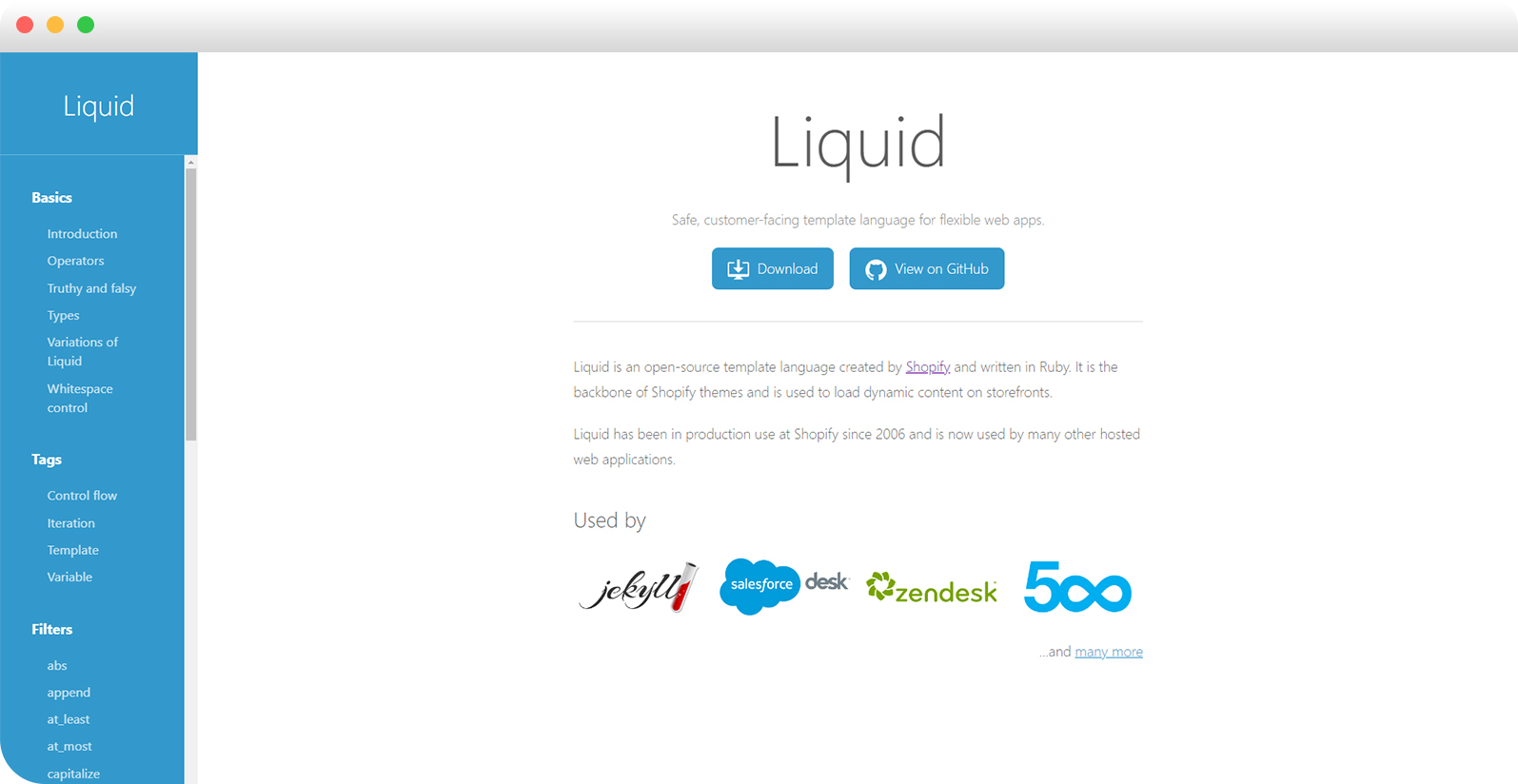
Besides, Shopify does provide API access and supports custom apps, but the flexibility is designed with guardrails to ensure stability and performance. For many businesses, especially those with standard eCommerce needs, Shopify Plus offers enough customization to get the job done without needing technical expertise. However, for companies that require full control over how their store functions and behaves, Shopify's limitations can become a bottleneck.
In contrast, Magento is highly praised for its developer-friendly architecture and unlimited customization capabilities. Businesses have full access to the platform’s source code, which allows them to:
- Build unique store layouts and customer experiences
- Create custom workflows and extensions
- Modify core functionalities
- Integrate deeply with third-party systems (like ERPs, CRMs, POS)
This modular codebase makes it easier for developers to add new features or customize existing ones without disrupting other parts of the system. Businesses that have unique operational requirements, such as complex product catalogs, B2B workflows, or region-specific functions, often find Magento to be the most flexible solution available.
The Verdict
The prize goes to Magento. It offers unmatched flexibility through deep code access and developer tools, ideal for those seeking complete control over their online store. While Shopify Plus does not provide the same depth of customization, it requires less technical expertise, making it accessible to a broader range of businesses.
SEO Functionalities (Magento wins)
Shopify Plus offers a strong foundation for SEO, especially for users who want results without diving into technical details. Some of its key strengths include:
- Auto-generated sitemaps and robots.txt files
- Editable meta titles and descriptions

- Built-in SSL certificate
- Mobile-optimized themes for better user experience and speed
However, Shopify does have some SEO limitations that are important to consider. One of the most commonly cited drawbacks is the platform’s rigid URL structure. For example, you cannot remove or customize paths like /collections/ or /products/, which can be less ideal for SEO-conscious businesses. While this restriction can be worked around using third-party apps, those solutions often come with added costs and technical complexity.
Meanwhile, Magento offers an exceptional level of control over SEO elements, making it a strong choice for businesses with complex SEO strategies. Some of Magento’s standout SEO features include:
- Custom URL structures: Merchants can easily create clean, keyword-rich URLs for product and category pages.
- Advanced metadata management: Titles, descriptions, and meta tags can be manually configured at a granular level.
- Canonical tags: Helps prevent duplicate content issues by indicating preferred pages to search engines.
- Schema markup: Developers can add rich data snippets (e.g., product ratings, pricing) to improve visibility in search results.
- Image optimization and alt tag editing: Ensures every image is crawlable and enhances on-page SEO.

Magento also supports server-side rendering and gives merchants full access to their website’s architecture, which allows for in-depth customization of technical SEO settings.
The Verdict
Magento is better if you need advanced SEO control and customization, provided you have the technical resources. Shopify Plus is ideal for those who prioritize ease of use and are okay with some SEO limitations, but opting for a headless setup can mitigate these restrictions.
Security (Shopify Wins)
Shopify Plus is a hosted Software-as-a-Service (SaaS) platform, which means all security responsibilities are handled by Shopify itself. This includes server maintenance, data protection, vulnerability monitoring, and compliance with international standards. Shopify Plus is Level 1 PCI DSS compliant by default, meaning merchants don’t need to worry about managing their own compliance measures. This level of certification is essential for securely processing credit card transactions.
Additionally, Shopify Plus provides SSL encryption on every store, ensuring all customer data is securely transmitted across the web. Shopify also performs regular platform-wide security updates and penetration testing to proactively address any vulnerabilities. For large enterprises, this level of security assurance significantly reduces risk while simplifying operations.
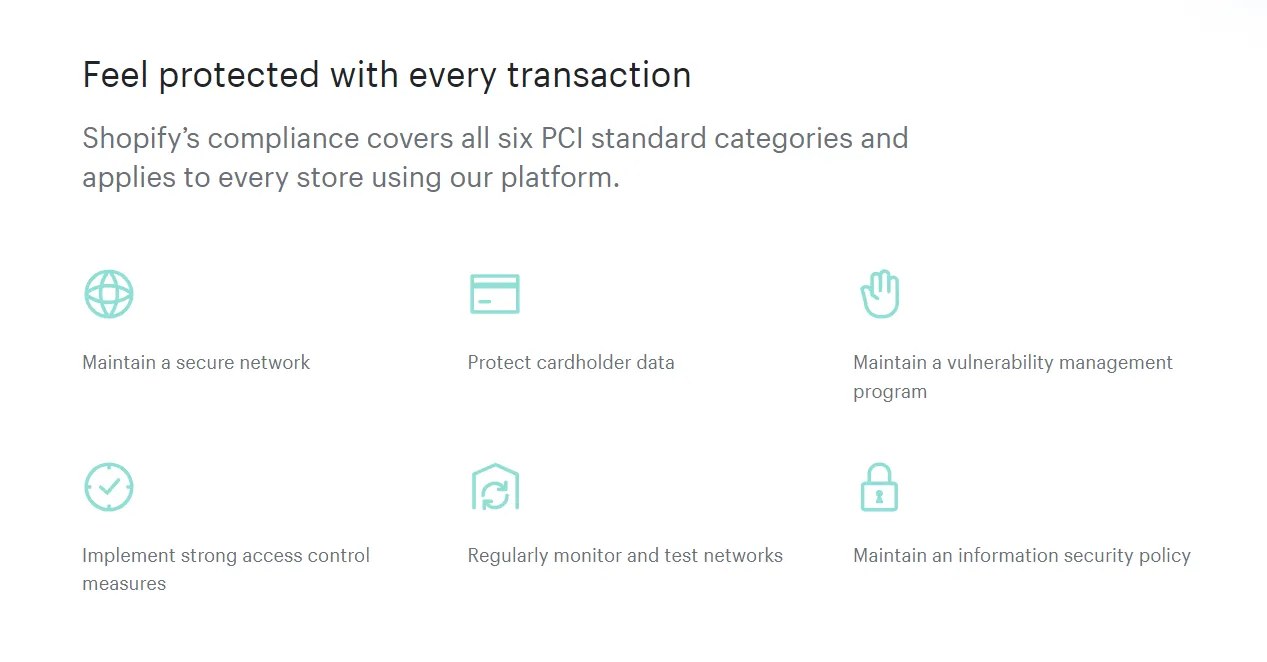
Because Shopify controls the entire tech stack, merchants don’t need to invest in dedicated security teams or worry about server misconfigurations, outdated plugins, or data breaches caused by third-party code, issues that can be common on self-hosted platforms. This makes Shopify Plus a trusted choice for businesses that want reliable, hands-off security with minimal overhead.
So what's about Magento / Adobe Commerce? This platform puts the responsibility for security largely in the hands of the merchant. While Magento can be made highly secure, doing so requires technical expertise and regular attention. Merchants must manage their own hosting environment, install updates, patch vulnerabilities, and ensure PCI compliance independently, either with in-house developers or through an agency.
Magento does provide flexibility for implementing advanced security protocols, but without a dedicated team or managed service, businesses may face increased risk from outdated software, misconfigured servers, or unpatched extensions. Adobe does offer a cloud-hosted version of Magento with enhanced security support, but it still requires more hands-on management than Shopify Plus.
The Verdict:
Between Shopify Plus vs Magento, Shopify Plus wins the security category because it provides a fully managed, secure environment right out of the box. For enterprise businesses looking for peace of mind, compliance assurance, and minimal manual effort, Shopify Plus delivers a reliable and scalable security foundation.
Community & Support (Shopify Plus wins)
Adobe Commerce offers application-level support, meaning a team with technical expertise is readily available to assist with complex issues. However, this approach prioritizes developers, and readily available, user-friendly support options like phone or live chat are often absent.
You can find more support from the platform community. Historically, Adobe Commerce boasted a vibrant community of skilled developers who offered valuable support and expertise. This community is still present, but its size has declined as some developers moved to other platforms like Shopify Plus.

For a monthly license fee, Shopify Plus merchants can access 24/7 dedicated account management via phone, email, or live chat. These Launch Managers (CSMs) are highly knowledgeable and can assist with technical issues, platform-related questions, and bug fixes, as well as provide guidance on marketing and conversion rate optimization.

Adding to that, Shopify's developer community is growing rapidly and is fueled by initiatives like Hydrogen (an open-source project). They're continuously opening up their platform with new APIs, further solidifying their developer ecosystem.
The Verdict
In this comparison between Shopify Plus vs Magento, it is evident that Shopify Plus excels in customer support, which is one of its key selling points.
How to Choose Between Shopify Plus vs Magento
Choosing between Shopify Plus vs Magento isn’t just about comparing features. It’s about aligning the platform with your business goals, team capabilities, technical needs, and long-term growth strategy. Each platform serves a different type of merchant, so understanding where your business fits will help you make the right choice.
Our advice is that before deciding on the solution for your business, ask yourself the following questions:
- What is my budget for development and ongoing maintenance?
- Do I need deep customization or complex workflows?
- Do I have in-house technical resources or a development partner?
- How important is speed to launch and ease of use?
- Is SEO a core part of my growth strategy?
- Am I planning for international expansion or advanced B2B selling?
By answering these questions, you can begin to identify which platform better suits your operational style and customer experience goals.
Shopify Plus vs Magento – FAQs
Is Adobe Commerce Cloud better than Shopify Plus?
Adobe Commerce Cloud and Shopify Plus each have strengths depending on your business needs. Adobe Commerce Cloud excels in advanced customization, B2B functionalities, and scalability for large enterprises. Shopify Plus offers ease of use, extensive app integrations, and competitive pricing structures tailored for rapid growth and flexibility.
What are the limitations of Shopify Plus?
Comparing Adobe Commerce vs Shopify Plus, the latter platform may have limitations in advanced B2B functionalities, complex customization, and flexibility in managing multiple international storefronts. It also requires additional apps for some features that are native to Adobe Commerce.
Why choose Adobe Commerce?
You can choose Adobe Commerce for robust B2B capabilities, advanced customization options, and scalability suitable for large enterprises. It provides comprehensive tools for managing complex business needs, including extensive integrations and a strong ecosystem of support.
When should you switch to Shopify Plus?
It might be time to upgrade to Shopify Plus when your business reaches $800,000 in monthly sales or exceeds 100 transactions per minute. This level of growth often requires a more robust platform like Shopify Plus to handle increased traffic, transactions, and customization needs effectively.
For seamless migration to Shopify Plus, you can consider working with the experts at LitExtension - #1 eCommerce Migration Service. With 12 years of experience, we have clearly gained a deep understanding of Shopify Plus’s data structure.
Does Adobe Commerce support multi-language and multi-currency features?
Yes, Adobe Commerce (Magento) fully supports both multi-language and multi-currency features. You can create multiple store views within a single Magento installation, allowing you to serve different regions with localized content, currencies, and pricing. This makes Magento an excellent choice for international businesses that want to provide tailored shopping experiences for customers in different countries.
Is Shopify Plus worth it?
Yes, Shopify Plus is worth it for businesses that want a fully hosted, enterprise-grade solution with minimal technical overhead. It is ideal for fast-growing brands that prioritize speed to launch, ease of management, and reliable 24/7 support. Shopify Plus includes advanced automation tools, dedicated account managers, and access to exclusive features like Shopify Flow and Launchpad, which help streamline operations at scale.
Final Thoughts
In the end, the choice between Adobe Commerce vs Shopify Plus boils down to your specific business needs. If you're still unsure, hopefully, our analysis of all aspects of both platforms has helped you to make the decision.
No matter which platform you choose, LitExtension – the #1 eCommerce Migration Service is here to provide a seamless migration service. With over 12 years of experience and a deep understanding of both Adobe Commerce vs Shopify Plus data structures, we guarantee you get the best experience. Contact us today for more information!
For more eCommerce insights, you can check out our LitExtension blog or join the community group.

